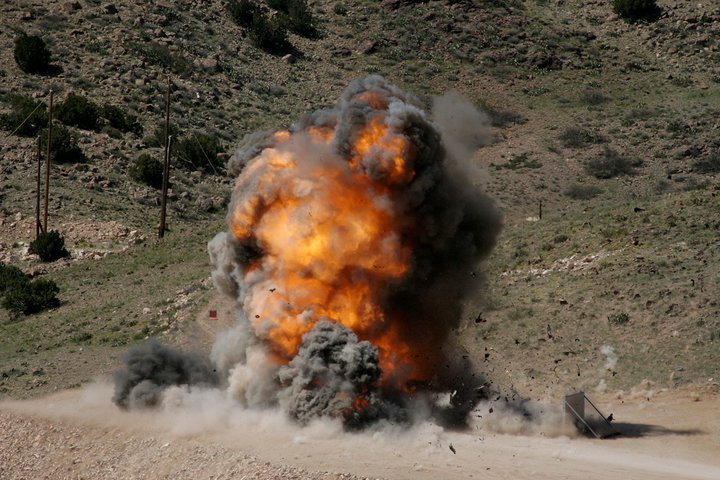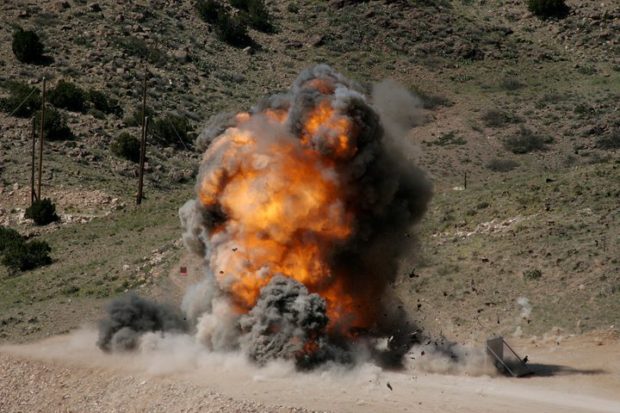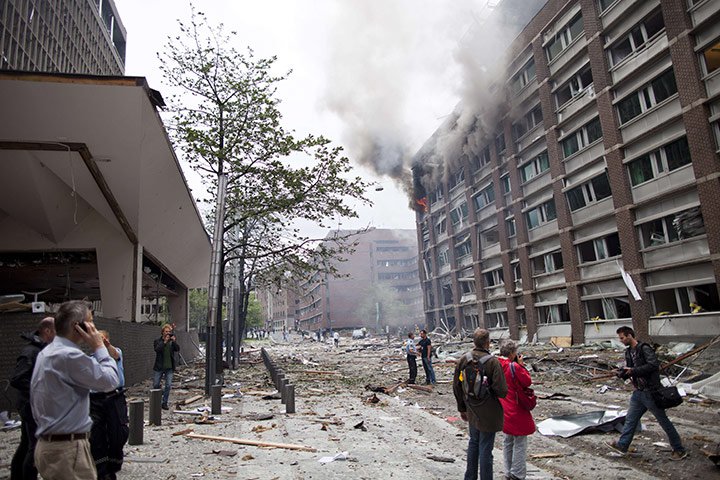Written by Greg Ellifritz
Terrorists worldwide use bombs as their weapons of choice. Occasionally, these bombs will be supplemented by sniper fire, grenades, or active shooters but it’s the bombs that get media attention. Many of my readers have been to numerous shooting schools and have trained in martial arts for years. How many of you have ever taken a bomb class? While this article isn’t a substitute for formal training, it will give you some tips that may prevent you from being blown up should you happen to be caught in the middle of a suicide or homicide bombing.
I will be referencing some of the most recent “western” terrorist bombings of civilian targets…the Moscow airport bombing and the bombing of the government building in Oslo, Norway (both in 2011). While the bombers used different tactics (The Moscow bombers were suicide bombers. The Oslo bomber placed the bomb in a car), the tactics of avoidance, minimization of risk, and response remain the same. The two events serve as very useful contrasts and case studies to teach proper response tactics for anyone involved in a similar incident or anyone who might have to respond to the aftermath.
We haven’t seen many bombings (specifically suicide bombings) in the USA, but they are coming. Bombs are the weapons of choice among terrorists worldwide. It’s only a matter of time that they become more commonplace here. Read the information below NOW, so that you’ll be ready when it happens here.
First, get it out of your head that a bomb looks like a bunch of taped up road flares with an alarm clock attached. Bombs can look like or be concealed in ANYTHING. In one bomb class I took, we made a bomb and concealed it in a flowerpot with a live plant covering it. We had it triggered with a motion detector that detonated the bomb when someone came within two feet of the flowerpot! If the terrorist wants to blow you up badly enough, he’ll probably succeed and you’ll never know what hit you.
Despite this fact, some terrorists and bombers are not that smart. Sometimes you might be able to identify a suicide bomber before he detonates. Here’s what to look for:
– Clothing that is bulky or excessive for the weather (to hide the bomb)
– Hands hidden (possibly holding the switch to detonate the bomb)
– A strange chemical odor or excessive cologne to cover up that smell
– The bomber focused, but unresponsive. Suicide bombers often have the “1000 yard stare” and are usually unresponsive to questions or commands
– Heavy luggage or backpacks that don’t fit the situation. The average weight of a bomb used by a suicide bomber is around 20 lbs. The Madrid train bombers all had very heavy backpacks. The Moscow bomber placed his bomb in a rolling suitcase. Not all the bombers wear their bombs.
– Nervousness, excessive sweating, or repeated mumbling of a prayer or mantra
– Exposed wires anywhere on a person’s body
– Repeated attempts to avoid security checkpoints and/or police officers
Beware of any suspicious packages. The bomber might not be a suicide bomber. He or she might just plant the bomb and walk or drive away. Although it didn’t get nearly the attention of the 2011 Russian airport bomb, on the same day a bomber blew up a bus in the Philippines. Two people were killed and over a dozen injured when two bombers placed a package under the seat of a bus. The package contained a modified 81mm mortar shell and a cell phone. The bombers left the package, got off the bus and called the cell phone, thus triggering the bomb. If the bomb is not worn by a terrorist, it is most likely to be hidden in a car, discarded backpack or duffel bag, or placed in a trash can.
What should you do if you notice a person with one or more of these descriptors or even a suspicious package? GET AWAY! Time, distance, and shielding are the only defense. Realize that a 20lb suicide bomb vest loaded with shrapnel is dangerous within 400 meters. That’s a long distance! Recent research has determined that 15 meters (about 50 feet) is the distance that means the difference between life and death in most suicide bombing incidents. If you are within 15 meters of the bomber when he detonates, you will likely die. If you are beyond 15 meters, you will likely live, but may be seriously injured.
Ultimately, whether you live or die depends on the terrain, the type of bomb and shrapnel and how far away from the bomb you are. The farther away you can get, the better off you will be. Ideally, distance combined with some type of cover that will stop shrapnel and projectiles is best. For the 500kg Oslo car bomb, people were likely hit by shrapnel up to 1/2 mile away.
Personally, if I noticed a suspicious package or thought someone might be carrying a bomb, I would make it my primary objective to get myself and loved ones as far away from the bomb/bomber as possible. Once I’ve made it to safety, I will report the person to police. I’m not going to hang around in the kill zone looking for a policeman.
If you are armed with a firearm, should you shoot the bomber? That is a tough call. If you are right about your guess and kill the bomber before he detonates, you will be a hero. If you are wrong you will be either blown up or arrested. It makes the decision a little difficult.
I will say this…if you decide to shoot the bomber, you must expect to die. Remember that danger zone of 400 meters I talked about earlier? How many of you can make a head shot at 400 meters with your concealed carry pistol? If you can’t, you are in the kill zone. If the bomber detonates you may be seriously injured or killed. By definition, if you are close enough to take a shot, you are going to be within range of the bomb’s blast. If you do shoot the bomber, you must go for a head shot. If he is wearing a bomb vest, your bullet will likely detonate the bomb if you hit it.
The biggest problem is that you don’t know how the bomb is set to go off. Even if you instantly incapacitate the bomber with a brain stem shot, the bomb still may detonate. It could be on a timer, it could be command detonated by another person watching discreetly from afar, the terrorist could have a “dead man switch”, or your bullet could cause it to blow. The possibilities are endless. Like I said, if you engage you have to expect to be blown up.
On the other hand, how quickly can you run 400 meters or get to cover? For most of you reading this article, consider 90 seconds a bare minimum of time necessary to get to safety. That’s a long time. Running might not assure your safety. Your best chance may be shoot the bomber. There’s just no guarantee that he won’t blow himself up before you get away.
See what I mean about it being a tough call? Damned if you do. Damned if you don’t. If you carry a defensive firearm, you need to decide what you are going to do BEFORE it happens. Study the subject and make your decision now. You won’t have time to consider all the variables in the heat of the moment.
After the Engagement or Detonation
Whether you decide to shoot or even if the terrorist blows the bomb before you engage, there are a few things that you should be thinking about.
Often terrorist bomber have “handlers”, “dispatchers”, or security people assigned to them. The role of these people is to protect the bomber in case anyone intervenes or to detonate the bomb if the terrorist gets cold feet. Watch out for these people. Scan for anyone who appears to be paying undue attention to the situation, especially if that person is behind some type of cover or at a discreet distance away. If you choose to shoot, you may be in a fight with more than just the bomber.
Information reported by Debka and The London Telegraph suggest that there were AT LEAST three other people besides the bomber involved in the Russian incident. Some reports are stating that the actual bomber was a female and she had a male accomplice at her side to appear less conspicuous. One to three other conspirators observed from a safe distance away. Consider that when deciding to take the shot. Not only are you dealing with a powerful bomb, but you may have to fight five other people as well. And those folks likely had guns. And don’t forget the Manila bombing mentioned above. What do you think was the role of the second person on the bus? It’s likely that he was providing extra security in case the bomber was discovered before he planted the device.
Look for people watching who are not scared or stunned. The Russian handlers were all on cell phones. That may be another tip off. Most modern terrorist bombs use cell phones as triggers (switches). The handlers may be on the phone reporting to their superiors or they may be planning to set off another bomb.
Also be cautious of people in uniforms. The Oslo bomber facilitated his later shooting by wearing a police uniform and ordering the kids to approach him. When they did, he killed them with a rifle. I don’t know if he was wearing the police uniform when he set the car bomb, but it’s possible. Watch for people dressed in fake police, security, or fire department uniforms telling you to do what doesn’t seem safe. Use your common sense and flee if you think it’s a ruse. It’s also a good idea to get to know what all of the police uniforms in your area look like so that you may be able to tell the difference between a real cop and an impostor during a bombing incident.
If you shoot the bomber, or even if you just see the bomber blow up, do not approach the body. You don’t know if there is another bomb planted on him, if the primary bomb is on a time delay, or if it is command detonated by another person. Keep far away. Try to get everyone else away too. Move quickly to cover after you shoot or he blows up.
Reportedly, the Russian bomb was triggered by the act of the bomber opening the suitcase. Resist the temptation to open any potential bomb to see what it is. If you think it’s a bomb, then treat it like a bomb. Get away and get to cover.
Beware of secondary devices. Oftentimes bombers will use more than one bomb. The original bomb is just designed to create havoc and bring in first responders. A second bomb placed in an evacuation zone, obvious command post staging area, or near the body is designed to injure more people, specifically fire and police officers.
After one bomb goes off, look for items that seem out of place…discarded baggage or backpacks, strange pieces of trash, or recently disturbed ground. If you see any of these things, get away from them. If a bomb goes off, don’t evacuate into a parking lot. Cars are the easiest place to hide large amounts of explosive for a secondary device. One very common tactic is to place a small bomb in or near a building or public area. The terrorist knows that the small bomb will trigger an evacuation. He will then place a bigger bomb at the evacuation site to blow up all of the evacuees. I’m repeating myself, but this is very important…NEVER EVACUATE TO A PARKING LOT. It’s too easy to hide a (big) bomb in a car. Get far away from anything that may conceal a secondary device.
As far as we know, the Russian and Oslo bombers did not use secondary devices, but we do know that the Oslo bomber had at least one additional explosive device on his person when arrested. He could have placed that device and made his casualty lists even higher.
Medical Care
If you or others are in the vicinity of a bomb blast you will likely see deaths and serious injuries. Expect that and don’t be stunned. Act! There are several videos of the immediate post blast of the Oslo bombing. People are staggering around dazed and unsure of what to do. Don’t be one of those people. Expect to see serious bleeding, hearing loss, confusion, head injuries and internal injuries. The victims may not be able to walk or hear you.
This is one time when laying the injured person down to prevent spinal injury is counterproductive. Move the injured AWAY from the bomber or bombing area as quickly as possible as there may be a secondary device in the area. C-spine stabilization won’t really matter if the injured person is laying on top of another bomb. Yes, movement may further injure a casualty, but bombing victims seldom have the types of injuries that are aggravated by movement. Get the injured to a safe place so that they aren’t blown up again.
Establish a casualty collection point behind some hard cover in an area that is as far away from the original bomb as possible. Clear this area of secondary devices before unloading casualties. It may take a while for EMS to enter the scene. Be prepared to treat life threatening bleeding first (you should know how to make or use a pressure bandage and a tourniquet) then follow up with airway and breathing stabilization and other injuries. Take a few minutes to get online and review first aid for penetrating trauma, burns, and head injuries.
Learn how to improvise bandages and tourniquets. In every terrorist bombing, there have been lives saved because bystanders have known some basic medical skills and have acted quickly. My article Field Medicine for Terrorist Attacks is a good place to get you up to speed quickly if you can’t find any “real” medical training.
Keep these thoughts in mind. Get some training and stay safe

This is a 500 lb car bomb I helped build in one of my classes. This picture was taken from 3/4 mile away. The Oslo bomb was twice the weight of this one.



